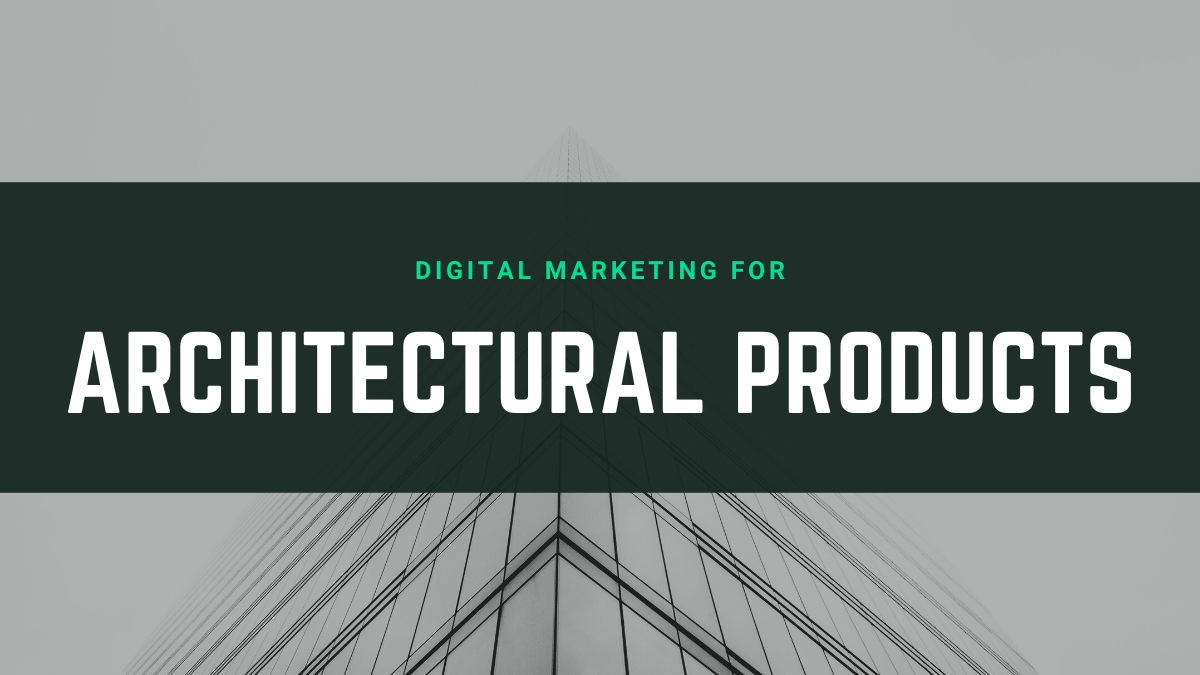
Digital Marketing for Architectural Products
Your architectural products are designed with precision, beauty, and function in mind. But how do you ensure that the right architects, designers, and builders see them? In a field that has long relied on trade shows, print catalogs, and word-of-mouth, the shift to digital can feel daunting. The good news is that digital marketing isn't as complicated as it sounds. It's about meeting your audience where they already are: online.
This guide will walk you through the essentials of digital marketing for architectural products. We’ll break down the key strategies that can help you showcase your products, connect with decision-makers, and grow your business. You'll learn how to build an online presence that works for you, even while you sleep.
Why Your Business Needs Digital Marketing
Think about the last time an architect or specifier needed to find a specific product. Did they flip through a dusty catalog or did they open a new tab on their browser? More often than not, the search starts online. If your products aren't visible during that search, you're missing a huge opportunity.
Digital marketing allows you to reach a global audience, not just those who attend a specific trade show. It helps you tell your product's story in a compelling way, using high-quality images, videos, and detailed specifications. You can build relationships with potential clients, educate them on your product’s value, and position your brand as an industry leader. It's about making it easy for the right people to find, specify, and buy your products.
Example in Action:
Imagine a mid-sized architectural hardware manufacturer that previously relied on regional expos to get noticed. By building a website optimized for terms like “modern brass door handles,” they started drawing in inquiries from architects across the country who discovered their products online.
Mastering SEO: Be Found When It Matters

Search Engine Optimization (SEO) is the process of making your website more visible on search engines like Google. When an architect searches for "sustainable commercial cladding" or "minimalist door hardware," you want your website to appear at the top of the results.
Find Your Keywords
Keywords are the terms your audience uses to find products like yours. Your first step is to think like your customer. What would they type into Google? Your keywords should be specific. Instead of "windows," a better keyword might be "energy-efficient triple-pane windows for residential projects."
Use free tools like Google Keyword Planner, Ubersuggest, or Answer the Public to find popular search terms related to your products. Look for long-tail keywords (phrases of three or more words) as they often have less competition and attract more qualified buyers.
Actionable Tip:
Try brainstorming a list of 10–15 keywords that match your product lines. Test them in Google search—see what comes up and whether your competitors are already ranking for these terms.
Optimize Your Website
Once you have your keywords, you need to use them on your website. Here's where to focus:
-
Page Titles and Descriptions: Each page on your site should have a unique title and description that includes your target keyword.
-
Headings and Content: Structure your page content with clear headings (H1, H2, H3). Weave your keywords naturally into the text, focusing on providing useful information.
-
Image Alt Text: Search engines can't "see" images. Alt text is a short description of an image that helps them understand what it is. Describe your product images accurately, using keywords where appropriate (e.g., "black aluminum casement window").
Practical Example:
A company selling architectural ceramic tiles updated its product pages to include titles like "Handmade Italian Ceramic Wall Tiles for Kitchens." They also added keyword-rich descriptions and alt text, leading to a surge in organic traffic.
Content Marketing: Educate and Inspire

Content marketing is about creating and sharing valuable information to attract and engage your audience. For architectural products, this isn't about a hard sell. It's about becoming a trusted resource. Architects and designers are always looking for inspiration and technical information. Your content can provide both.
Project Case Studies
Showcasing your products in action is one of the most powerful marketing tools you have. Create detailed case studies for projects that feature your products. Include stunning professional photography, project challenges, and how your product provided the solution. Talk about the architect's vision and how your product helped bring it to life.
Actionable Tip:
Reach out to architects who use your products and offer to feature their projects on your website. They get visibility, and you get authentic, real-world examples of your product in action.
Blog Posts and Guides
Start a blog to answer your customers' questions. Write articles that provide real value.
-
How-to Guides: "How to Specify Fire-Rated Doors for Commercial Buildings"
-
Comparison Posts: "Aluminum vs. Vinyl Windows: A Guide for Residential Architects"
-
Trend Reports: "Top 5 Trends in Sustainable Building Materials for 2026"
Your goal is to educate, not just promote. When you provide helpful information, you build trust and credibility.
Technical Resources
Architects and specifiers need easy access to technical data. Make sure your website has a dedicated resource library with downloadable files like:
-
CAD and BIM files
-
Product specification sheets
-
Installation guides
-
Warranty information
Making this information easy to find and download removes friction from the specification process and makes an architect's job easier.
Real-World Example:
A roofing supplier saw a spike in leads after adding a “resource center” where visitors could instantly download up-to-date technical sheets and specification files.
Social Media: Build Your Community

Social media is a powerful tool for visual storytelling, which is perfect for architectural products. You don't need to be on every platform. Choose the ones where architects and designers spend their time.
Platforms That Work for Architecture
-
Instagram: Ideal for high-quality photos and short videos. Use it to share beautiful project images, behind-the-scenes looks at your manufacturing process, and design inspiration.
-
Pinterest: This is a visual discovery engine where users collect ideas. Create boards for different product applications, styles (e.g., "Modern Farmhouse Exteriors"), and project types.
-
LinkedIn: The best platform for B2B networking. Connect with architects, builders, and developers. Share company news, case studies, and insightful articles to establish your expertise.
Actionable Tips:
-
Instagram: Post a mix of finished projects, works-in-progress, and close-ups of materials or textures. Use Stories to showcase short videos of installations.
-
Pinterest: Organize your boards by use case (residential/commercial) or aesthetic. Add detailed descriptions to each pin to improve discovery.
-
LinkedIn: Regularly share thought leadership content—a quick post about building trends or a short case study.
Tips for Social Media Success
-
Invest in professional photography and videography. Your products need to look their best.
-
Don't just post and ghost. Like and comment on posts from architects and design firms. Share their work (with credit) when it features your products.
-
Research and use relevant hashtags (e.g., #architecturaldesign, #buildingmaterials, #commercialconstruction) to increase the visibility of your posts.
Example:
A lighting manufacturer grew their Instagram following by launching a monthly photo contest, inviting architects to submit project photos that featured their products. Winners received gift cards, and the brand got a steady stream of high-quality user-generated content.
Email Marketing: Nurture Your Leads

Email marketing is a direct and personal way to stay in touch with your audience. It's about nurturing relationships with people who have already shown an interest in your brand.
Building Your Email List
You can't send emails without a list. Offer something valuable in exchange for an email address. This could be:
-
A downloadable guide (e.g., "The Architect's Guide to Daylighting")
-
Access to your BIM/CAD library
-
A monthly newsletter with project inspiration and product news
Place these offers on your website and promote them on social media.
Actionable Tip:
Add simple sign-up forms to your site, and make sure the benefits of subscribing are clear. You could even offer a once-off discount or entry into a prize draw.
What to Send
Your emails should provide value. A monthly newsletter is a great place to start. Include things like:
-
A featured project or case study
-
Your latest blog post
-
News about a new product or an upcoming trade show
-
An "inspiration of the month" photo
The goal is to keep your brand top-of-mind, so when your contact starts a new project, they think of you.
Example:
A building materials brand sends a newsletter each month, spotlighting a different architect and project that used their products. This not only provides value but also encourages others to share their experiences for a chance to be featured.
Common Mistakes to Avoid in Digital Marketing for Architectural Products
It's easy to fall into some common traps when marketing architectural products online. Here are a few mistakes to watch for:
-
Using Poor-Quality Photos: In a visual industry, low-quality images can hurt your brand. Invest in professional photography.
-
Neglecting Mobile Users: Many architects search for products on their phones. Make sure your website is responsive and loads quickly.
-
Overloading with Jargon: Try to keep your content clear and avoid heavy technical language that may turn off non-experts.
-
Inconsistent Branding: Whether it's your logo, color scheme, or the tone of your posts, keep branding consistent across all platforms.
-
Not Responding to Inquiries: Quick and friendly responses to online questions build trust and drive sales.
Actionable Tip:
Check your site on a mobile device and ask someone unfamiliar with your brand to give feedback on how easy it is to find information.
Emerging Trends in Digital Marketing for Architecture
Staying ahead means knowing what's coming next. Here are a few trends to keep on your radar:
-
Virtual and Augmented Reality: Allow clients to "walk through" projects using your products, right from their computer or mobile device.
-
Video Marketing: Short demo videos showing your products installed or animated explainer videos about how your products work are gaining popularity.
-
Interactive Product Selectors: Websites with tools that help architects choose finishes, colors, and specifications make the buying process smoother.
-
Personalization: Tailored website experiences or email content based on a visitor’s past activity can boost engagement.
-
Sustainability Content: With eco-friendly materials on the rise, highlighting green credentials and certifications is more important than ever.
Example:
A specialty glass supplier launched an interactive tool on their site that lets architects preview glass tints on real building facades. This boosted engagement and increased sample requests.
How to Measure the Success of Your Digital Marketing Efforts
If you can't measure it, you can't improve it! Here’s how you can see what's working and where to adjust your digital strategy:
Key Metrics to Track
-
Use tools like Google Analytics to see how many people visit your site and which pages they view most.
-
Track how many visitors download specs, request samples, or fill out contact forms.
-
See which emails get opened and what links are most popular.
-
Monitor likes, comments, shares, and click-throughs to your website.
-
Evaluate the types of leads you’re getting—are they architects, designers, or just general visitors?
Actionable Tips for Tracking
-
Set up Google Analytics and review reports monthly.
-
Use UTM tags (special bits of code in URLs) to track where your leads are coming from, especially for paid ads or social media campaigns.
-
Ask new contacts how they heard about you—sometimes a simple dropdown menu on your form can give great insights.
-
Establish clear goals, like "increase sample requests by 15% in the next quarter" or "grow Instagram followers to 2,000 by year-end."
Example:
A manufacturing company noticed that blog posts about fire-rated systems led to more quote requests than product pages, prompting them to write more educational content and further increase results.
Final Thoughts
Getting started with digital marketing doesn't have to be overwhelming. You can begin with small, manageable steps.
-
Start with Your Website: Make sure it is professional, easy to navigate, and clearly showcases your products. Begin optimizing your pages for one or two important keywords.
-
Choose One Social Platform: Pick one platform, like Instagram or LinkedIn, and commit to posting consistently. Focus on sharing high-quality images and engaging with your community.
-
Write Your First Case Study: Select a successful project and document it. Get great photos, write about the details, and publish it on your website as a blog post or a dedicated page.
Remember:
Be patient and persistent. Digital marketing is an ongoing process, and efforts compound over time. By focusing on helping and educating your audience, you can build a powerful digital presence that attracts the right clients and helps your business thrive.
30 minutes
Expert Consultation
Terms & Agreements
By booking a free 30-minute consultation, you agree to our terms, including scheduling, cancellation policies, and confidentiality. The session provides expert advice without guarantees of specific outcomes or results.






Leave a Reply
Your email address will not be published. Required fields are marked *